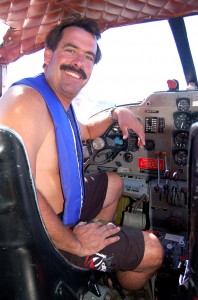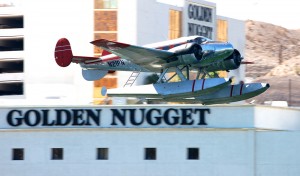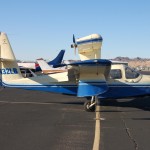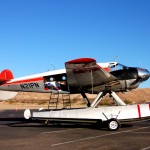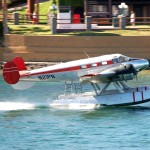
Sheble Aviation, a family owned and operated flight school, has a fleet of Cessna 172s and Beechcraft Travelairs.
By Bob Shane
In 1990, Joe Sheble and his wife, Valerie, established Sheble Aviation. The family owned and operated flight school, based in Kingman, Ariz., has a fleet of Cessna 172s and Beechcraft Travelairs. It also operates a Super Cub on floats and a Lake Buccaneer used for single-engine seaplane training. A certified flight instructor, Sheble holds all the ratings up to ATP multi-engine, is a commercial helicopter pilot and has an A&P mechanics license. Of his 12,000 flight hours, 4,500 are in seaplanes. Sheble is also a designated examiner for the Grumman Albatross.
Sheble, a man with an insatiable passion for flying, grew up around airplanes. As a child in the ?80s, he worked for his dad, who operated a flight school in Blythe, Calif. Sheble soloed at 16, got a commercial license at 18, and at 23, was the youngest pilot examiner in the country. It was while flying his dad’s Super Cub on floats that he began cultivating a particular fondness for water-based aircraft. He fell in love with the Twin Beech on floats when he checked out in one as part of obtaining a multi-engine sea rating when he was 22.
It wasn’t until February 2007 that Sheble fulfilled his dream of owning a Twin Beech on floats. It was one of those fortuitous occurrences. Tom Allen, a flight instructor working for Sheble, was in the office of a Phoenix glider airport when he saw a posted “for sale” notice regarding a Twin Beech on floats. He made a quick call to Sheble, who quickly flew to Minneapolis to check it out. After traveling to the Surfside Seaplane Base in Lino Lakes, Minn., Sheble purchased the plane on the spot. The lake was frozen, so completion of the sale was contingent upon making a test flight when warmer weather prevailed. Sheble returned in the summer, made a successful test flight, and consummated the deal.
The Beechcraft Model 18 is a rugged and versatile aircraft. The first all-metal and multi-engine airplane produced by Beech, the prototype made its first flight in 1937. When construction ended in 1970, it had been in production for more than 30 years, the longest continuous production run of any piston-engine aircraft. Beechcraft built nearly 8,000 of the airplanes, including 32 variations of the basic design, and more than 200 approved supplemental type certificates were issued.
Sheble’s Twin Beech was originally a C-45 Expeditor for the Royal Canadian Air Force, which received delivery of the light transport in 1952. After more than a decade, it was retired from active military service in 1966, and stored until its sale in 1968. The aircraft subsequently flew for a succession of different commercial operators in Canada. From 1972 to 1987, Superior Airways, based in Thunder Bay, Ontario, operated the plane. During that period, the Twin Beech was put on a set of Edo floats built under license by Bristol Aerospace. In 1999, the floatplane made its way on to the U.S. register as N21PN, when purchased by Points North, an American company.
Once Sheble became the new owner of the rare Twin Beech, he had to formulate a plan addressing the logistics of moving the aircraft from the Minnesota lake region to Bullhead City, in the Arizona desert. Situated on the Colorado River near the confluence of three states—Arizona, California and Nevada—Bullhead City is located 90 miles southeast of Las Vegas.

Joe Sheble (left) and Tom Allen flew the Twin Beech floatplane on an exciting cross-country flight from the Minnesota lake region to Bullhead City, in the Arizona desert.
Moving the Twin Beech to its new home turned out to be a cross-country odyssey—a dogleg trip with many considerations factored into the formulation of the flight plan. Sheble needed to identify a multitude of unknowns before the trip. He put together an itinerary of fuel stops and locations where he would spend the night on the journey to Arizona. On Aug. 15, he departed Bullhead City in one of his BE-95 Travelairs to back-fly the route, surveying all of the proposed destinations. He checked for available facilities such as docks and mooring spots. He also identified potential hazards such as sandbars and telephone poles. After arriving in Seattle, he spent Aug. 17-20 building an approved fueling trailer that would attach to a ground vehicle and would then follow the Twin Beech, providing the aircraft with fuel along its route.
Sheble arrived in Minneapolis on Aug. 22, and along with his copilot, Tom Allen, spent two days preparing the floatplane for the flight to Arizona. They departed Wipaire’s seaplane base, south of St. Paul on the Mississippi River, on Aug. 25. Sheble planned most of the flight legs to be three to three and a half hours, giving the ground vehicle carrying fuel time to catch up. Their first stop was Bush’s Landing on Lake Oahe, near Pierre, S.D.
The next day, the Twin Beech flew on to Fort Peck, Mont., and landed on the Missouri River. After refueling, it continued on to Flathead Lake, Mont. The crew waited there for three days for a new battery; they couldn’t get a 24-volt battery locally, and there was no overnight delivery service to that area. On Aug. 30, the plane finally continued on to Portland, Ore., where it set down in the Columbia River. The next day they made it to Lake Shasta, near Redding, Calif. On Sept. 1, after a three-hour flight, the plane touched down on Lake Isabella, near Kernville, Calif., encountering stiff winds and whitecaps on the lake’s surface. When the truck carrying the fuel broke down, some local residents saved the day by driving back and forth with five-gallon jerrycans while the crew hand-fueled the aircraft. Refueled, the plane took off with its thankful pilot; two and a half hours later, it touched down on the Colorado River near Topock Gorge, Ariz., 30 miles south of Bullhead City.
It took a week to ferry the Twin Beech back to its new home in Arizona. With the exception of having to replace a battery, the aircraft performed impeccably. Sheble encountered temporary flight restrictions over wildfires in western Montana and terrain clearance issues that briefly pushed the aircraft up to 13,500 feet. Sheble said the only scary part of the trip was flying over a mountainous and densely forested area of Oregon for a long stretch. While straight mileage would have been 1,900 miles, the actual flight miles flown were 3,000, with the ground support vehicle covering almost 5,500 miles. The trip appropriately ended at the beginning of the Labor Day weekend, providing the flight crew with a much-needed holiday.
Sheble eventually flew the Twin Beech up the Colorado River to Bullhead City, put on its beaching gear and parked in the parking lot of the Bullhead Area Chamber of Commerce. It became a magnet for passing motorists.
“We were very pleased with the amount of traffic that the plane drew to our visitor’s center,” said Teri Tomlinson, the chamber’s director of operations. Currently, the plane is moored on the Colorado River at Fort Mohave.
Sheble views the Twin Beech on floats as a “houseboat with wings,” and uses the aircraft for family recreation such as fishing and camping. He plans to use the aircraft for twin-engine seaplane training in the future.
The Bullhead City area is a premier location for flight training. It offers year-round perfect flying weather and is convenient for training in an environment that offers the complete spectrum of water conditions encountered in both river and lake operations. The student pilot can navigate the Colorado River, one of the fastest moving rivers in the country. Strong wind and rough water conditions are common. Just two miles up the river, backed up behind Davis Dam, is 67-mile-long Lake Mohave. Forty miles to the south is Lake Havasu.
Adjacent to the river is Laughlin/Bullhead International Airport (IFP), providing easy access to the region. Just across the Colorado River from Bullhead City are Laughlin’s 11 major resort casinos, providing year-round entertainment. It’s a great place to relax after a day of intense seaplane training.
Sheble’s vintage Twin Beech on floats has become a common sight flying up and down the Colorado River. Soon it will be the vehicle making it possible for Arizona pilots to earn their MES rating.
For more information, visit [http://www.shebleaviation.com].
- Sheble Aviation Flight School uses this Lake Buccaneer amphibian for single-engine seaplane training.
- Laughlin/Bullhead International Airport overlooks Bullhead City, across the river from Laughlin’s resort casinos.
- Following its arrival in Bullhead City, Joe Sheble parked the aircraft in the parking lot of the Bullhead Area Chamber of Commerce, where it drew the attention of many passing motorists.
- Inspired by the sight of the Twin Beech on floats, Garry Mayer, a local artist, captured the image in one of his drawings.
- Laughlin casinos tower above the vintage aircraft as it taxis up the Colorado River.
- The Colorado River makes a perfect natural runway for the Twin Beech.












